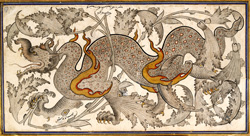Dragons and Dinosaurs

Sayyid Naqqash Dragon (Fg. 10-5)
The Bible talks in detail of an enormous, fire breathing, twisted coil creature called Leviathan in the book of Job. In most ways traditionally, Leviathan fits descriptions of dragons found in ancient cultures around the world, either as a large snake of the sea, or large flying snake from the heavens. Characteristics of dragons commonly emphasize the mixture of a lizard and serpent while being portrayed as dangerously destructive and wiser than man although there are legends of friendly snakes who are inclined to help mankind. Stories of drakon (Greek) creatures date back thousands of years well beyond their modern age title. One can't help but notice the strange resemblance of flying serpent dragons, or sea dragons, to that of artistic reconstructions of ancient dinosaurs.
Many features are very similar especially in the case of wyverns, with two large clawed feet and a body shape (including the tail) similar to carnivorous dinosaurs. How would nearly every major civilization around the world make reference to a dinosaur type creature well before archeologists pieces any of the bones together? Some theorists suggest ancient civilizations might have lived alongside dinosaurs as evident in ancient artwork such as the Ica Stones and carvings from the Aztecs.
These ideas are highly contested due to an enormous gap in accepted dating methods between dinosaurs and the aforementioned cultures, but their artifacts do provide some sort of indication that our ancient ancestors may have been influenced in some way by creatures of this type. Details present in a number of sculptures are suspect of actually seeing creatures on a basis regular enough to accurately represent them in pottery, stone and clay; Features in some cases are absolutely astounding how closely the figures represent present day depictions of certain species of dinosaurs, giving the idea dinosaurs may not be as old as mainstream theories suggest.
† Article 10-5
